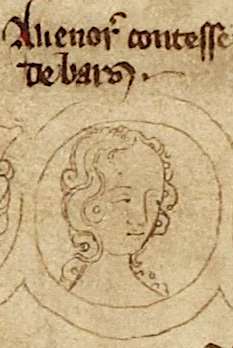Eleanor of England, Countess of Bar
Eleanor of England (18 June 1269 – 29 August 1298) was an English princess, the eldest surviving daughter of King Edward I of England[1] and his first wife, Queen Eleanor of Castile.
| Eleanor | |
|---|---|
 Depiction of princess Eleanor on the family tree | |
| Countess of Bar | |
| Tenure | 1293 – 12 October 1298 |
| Born | 18 June 1269 Windsor Castle, Windsor, Berkshire |
| Died | 29 August 1298 (aged 29) Ghent, County of Flanders |
| Burial | 12 October 1298 |
| Spouse | |
| Issue | Edward I, Count of Bar Joan of Bar, Countess of Surrey Eleanor? |
| House | Plantagenet |
| Father | Edward I of England |
| Mother | Eleanor of Castile |
What evidence exists for Eleanor's early years suggests that while her parents were absent on Crusade between 1270 and 1274, she became very close to her paternal grandmother, Eleanor of Provence, with whom she continued to spend a good deal of time. She was also close to her sickly brother Henry. On one Pentecost Eve, Henry and Eleanor were given two partridges for their dinner, for a special treat.
For a long period Eleanor was betrothed to King Alfonso III of Aragon.[1] Alfonso's parents were under papal interdict, however, because of their claims to the throne of Sicily, which were contrary to the papal donation of the Sicilian throne to Charles I of Naples, and despite the Aragonese ruler's repeated pleas that Edward I send his daughter to them for marriage, Edward refused to send her as long as the interdict remained in place. In 1282 he declined one such request by saying that his wife and mother felt the girl, who had just turned 13, was too young to be married, and that they wanted to wait another two years before sending her to Aragon. Alfonso died before the marriage could take place.
Eleanor subsequently married the French nobleman, Henry III, Count of Bar on 20 September 1293,[2] and had two children:
According to Kenneth Panton, Eleanor is credited with a daughter called Eleanor (b.1285), who supposedly married a Welshman named Llywelyn ap Owain.[4]
She died at Ghent on 29 August 1298. Eleanor was buried in Westminster Abbey but the location of her grave in the Abbey is unknown.[5]
Family tree
| Ancestors of Eleanor of England, Countess of Bar[6] | |||||||||||||||||||||||||||||||||||||||||||||||||||||||||||||||||||||||||||||||||||||||||||||||||||||||||||||||||||||||||||||||||||||||||||||||||||||||||||||||||||||||||||||||||||||||||||||||||||||||||||||||||||||||||||||||||||||||||||||||||||||||||||||||||||||||||||||||||||||||||
|---|---|---|---|---|---|---|---|---|---|---|---|---|---|---|---|---|---|---|---|---|---|---|---|---|---|---|---|---|---|---|---|---|---|---|---|---|---|---|---|---|---|---|---|---|---|---|---|---|---|---|---|---|---|---|---|---|---|---|---|---|---|---|---|---|---|---|---|---|---|---|---|---|---|---|---|---|---|---|---|---|---|---|---|---|---|---|---|---|---|---|---|---|---|---|---|---|---|---|---|---|---|---|---|---|---|---|---|---|---|---|---|---|---|---|---|---|---|---|---|---|---|---|---|---|---|---|---|---|---|---|---|---|---|---|---|---|---|---|---|---|---|---|---|---|---|---|---|---|---|---|---|---|---|---|---|---|---|---|---|---|---|---|---|---|---|---|---|---|---|---|---|---|---|---|---|---|---|---|---|---|---|---|---|---|---|---|---|---|---|---|---|---|---|---|---|---|---|---|---|---|---|---|---|---|---|---|---|---|---|---|---|---|---|---|---|---|---|---|---|---|---|---|---|---|---|---|---|---|---|---|---|---|---|---|---|---|---|---|---|---|---|---|---|---|---|---|---|---|---|---|---|---|---|---|---|---|---|---|---|---|---|---|---|---|---|---|---|---|---|---|---|---|---|---|---|---|---|---|---|---|---|
| |||||||||||||||||||||||||||||||||||||||||||||||||||||||||||||||||||||||||||||||||||||||||||||||||||||||||||||||||||||||||||||||||||||||||||||||||||||||||||||||||||||||||||||||||||||||||||||||||||||||||||||||||||||||||||||||||||||||||||||||||||||||||||||||||||||||||||||||||||||||||
| Wikimedia Commons has media related to Eleanor of England, Countess of Bar. |
References
- Merriman 1918, p. 321.
- Prestwich 1997, p. 389.
- Vale 2001, p. 211.
- Panton 2011, p. 173.
- https://www.westminster-abbey.org/abbey-commemorations/commemorations/eleanor-countess-of-bar
- Selby, Walford Dakin; Harwood, H. W. Forsyth; Murray, Keith W. (1895). The genealogist. London: George Bell & Sons. pp. 30–31.
Sources
- Merriman, Roger Bigelow (1918). The Rise of the Spanish Empire in the Old and in the New. Vol. 1. The Macmillan Company.CS1 maint: ref=harv (link)
- Panton, Kenneth (2011). Historical Dictionary of the British Monarchy. Scarecrow Press.CS1 maint: ref=harv (link)
- Prestwich, Michael (1997). Edward I. Yale University Press.CS1 maint: ref=harv (link)
- Vale, Malcolm (2001). The Princely Court: Medieval Courts and Culture in North-West Europe, 1270–1380. Oxford University Press.CS1 maint: ref=harv (link)